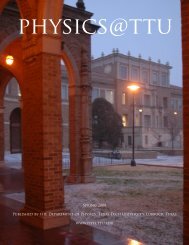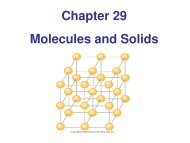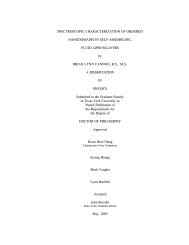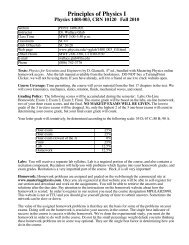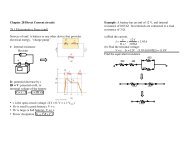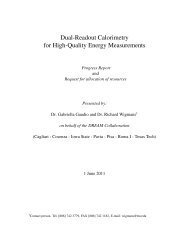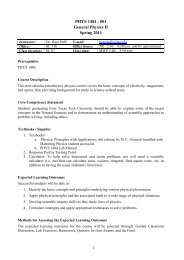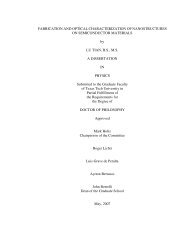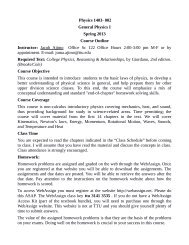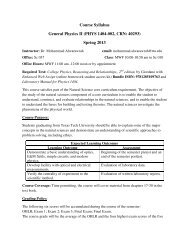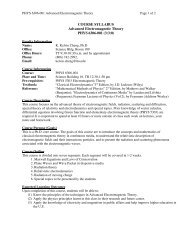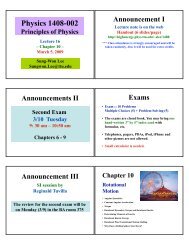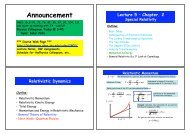Version One â Homework 1 â Juyang Huang â 24018 â Jan 16 ...
Version One â Homework 1 â Juyang Huang â 24018 â Jan 16 ...
Version One â Homework 1 â Juyang Huang â 24018 â Jan 16 ...
Create successful ePaper yourself
Turn your PDF publications into a flip-book with our unique Google optimized e-Paper software.
¡<br />
<strong>Version</strong> <strong>One</strong> – <strong>Homework</strong> 1 – <strong>Juyang</strong> <strong>Huang</strong> – <strong>24018</strong> – <strong>Jan</strong> <strong>16</strong>, 2008 12<br />
8. ‖ ⃗ E‖ = 4 π ɛ 0 a 2 Q<br />
9. ‖ ⃗ E‖ = 4 π ɛ 0 a Q<br />
Coaxial Cable 01<br />
24:05, calculus, multiple choice, < 1 min, normal.<br />
025 (part 1 of 4) 10 points<br />
A long coaxial cable consists of an inner cylindrical<br />
conductor with radius R 1 and an outer<br />
cylindrical conductor shell with inner radius<br />
R 2 and outer radius R 3 as shown. The cable<br />
extends out perpendicular to the plane<br />
shown. The charge on the inner conductor<br />
per unit length along the cable is λ and the<br />
corresponding charge on the outer conductor<br />
per unit length is −λ (same in magnitudes<br />
but with opposite signs) and λ > 0.<br />
−Q<br />
10. ‖ ⃗ E‖ = ɛ 0 Q a 2<br />
Explanation:<br />
Basic Concepts Gauss’ Law, electrostatic<br />
properties of conductors.<br />
Solution: Let us consider the Gaussian<br />
surface shown in the figure.<br />
+Q<br />
+<br />
+<br />
E + E<br />
+ S<br />
+<br />
+<br />
Due to the symmetry of the problem, there<br />
is an electric flux only through the right and<br />
left surfaces and these two are equal. If the<br />
cross section of the surface is S, then Gauss’<br />
Law states that<br />
keywords:<br />
Φ TOTAL<br />
= 2 E S<br />
= 1 ɛ 0<br />
Q<br />
A S , so<br />
E =<br />
Q<br />
2 ɛ 0 A .<br />
Q<br />
R 2<br />
R 3<br />
R 1<br />
Find the magnitude of the electric field at<br />
the point a distance r 1 from the axis of the<br />
inner conductor, where R 1 < r 1 < R 2 .<br />
1. E = 0<br />
λ<br />
2. E = correct<br />
2 π ɛ 0 r 1<br />
3. E =<br />
λ<br />
√<br />
2 π ɛ0 r 1<br />
4. E =<br />
λ<br />
√<br />
3 π ɛ0 r 1<br />
5. E =<br />
2 λ<br />
√<br />
3 π ɛ0 r 1<br />
6. E = λ R 1<br />
4 π ɛ 0 r 1<br />
2<br />
7. E = λ R 1<br />
3 π ɛ 0 r 1<br />
2<br />
8. E = λ2 R 1<br />
4 π ɛ 0 r 1<br />
2<br />
9. E =<br />
λ<br />
2 π ɛ 0 R 1<br />
10. None of these.<br />
Explanation:<br />
Pick a cylindrical Gaussian surface with the<br />
radius r 1 and apply the Gauss’s law; we obtain<br />
E · l · 2 π r 1 = Q ɛ 0<br />
λ<br />
E = .<br />
2 π ɛ 0 r 1<br />
026 (part 2 of 4) 10 points<br />
The electric field vector points<br />
1. in the negative ˆr direction



